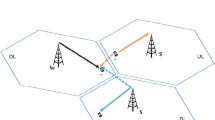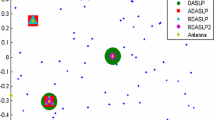Abstract
There is no theoretical time or frequency restrictions on capacity in DS-CDMA systems. In these systems, the signal to interference ratio (SIR) has a major effect on capacity. Since an increase in the user SIR at the base station (BS) leads to higher capacity, transmission power control is employed. The nonuniform distribution of users in the network causes different quality of service (QOS) in distinct regions, therefore network resources may not be utilized properly. A dynamic distribution algorithm can be employed to balance the QOS delivered in different regions of the network. In this paper, a novel dynamic distribution algorithm is introduced. The proposed algorithm deactivates certain users when the network encounters an overload. By applying this policy, the required SIR can be maintained for the remaining users.
Similar content being viewed by others
References
A.O. Fapojuwo, “Radio Capacity of Direct Sequence Code Division Multiple Access Mobile Radio Systems”, IEE Proceedings Part I: Communications, Speech and Vision, Vol. 140, No. 5, pp. 402–408, October 1993.
F. Behbahani and H. Hashemi, “Performance and Capacity Evaluations of CDMA Mobile Radio Systems-Reverse Link Analysis”, Proc. IEEE Vehicular Technology Conference, pp. 65–69, 1994.
K. Hamidian and J. Payne, “Capacity of a Novel Cell and Channel Model Using CDMA/FDMA Modulation Technique”, IEEE Pacific Rim Conference on Communications, Computers and Signal Processing, pp. 9–13, August 1997.
L.L.H. Andrew, “Measurement-based Band Allocation in Multiband CDMA”, Eighteenth Annual Joint Conference of the IEEE Computer and Communications Societies (INFOCOM), pp. 1364–1371, 1999.
B.E. Shrader, R.S. Karlsson, L.L.H. Andrew and J. Zander, “Power-Control-Based Band Allocation in Multiband CDMA”, IEEE Global Telecommunications Conference, 2001.
J. Zander, “Performance of Optimum Transmitter Power Control in Cellular Radio Systems”, IEEE Transactions on Vehicular Technology, Vol. 41, No. 1, pp. 57–62, February 1992.
J. Zander, “Distributed Cochannel Interference Control in Cellular Radio Systems”, IEEE Transactions on Vehicular Technology, Vol. 41, No. 3, pp. 305–311, August 1992.
H. Yanikomeroglu, “Theory of Transmit Power Control in Wireless Multiple-Access Systems”, Broadband Communications and Wireless Systems Laboratory Seminar Series, October 1999.
H. Alavi and R.W. Nettleton, “Downstream Power Control for a Spread Spectrum Cellular Mobile Radio System”, Proc. IEEE Global Telecommunications Conference, pp. 82–88, November 1982.
F.R. Gantmacher, The Theory of Matrices, Chelsea, New York, 1974.
R.W. Nettleton and H. Alavi, “Power Control for a Spread Spectrum Cellular Mobile Radio System”, Proc. IEEE Vehicular Technology Conference, pp. 242–250, 1983.
R. Prasad and T. Ojanpera, “An Overview of CDMA Evolution Toward Wideband CDMA”, IEEE Commununication Surveys, Vol. 1, No.1, pp. 323–331, 1998.
TIA/EIA-95B, “Mobile Station-Base Station Compatibility Standard for Dual-Mode Wideband Spread Spectrum Cellular Systems”, Baseline Version, Feb. 1999.
A.H.M. Ross and K.L. Gilhouse, “CDMA Technology and IS-95 North American Standard”, Mobile Communications Handpapers, J.D. Gibson (Ed.), pp. 430–448, 1996.
K. Leibnitz, “Impacts of Power Control on Outage Probability in CDMA Wireless Networks”, Proc. IFIP Int. Conf. Broadband Commun., Hong Kong, Nov. 1999.
A.J. Viterbi, CDMA Principles of Spread Spectrum Communications, Addison-Wesley, Reading MA, 1995.
J.X. Qiu and J.W. Mark, “A Dynamic Load Sharing Algorithm Through Power Control in Cellular CDMA”, Proc. Personal, Indoor and Mobile Radio Commun. Symp., pp. 1280–1284, 1998.
K. Takeo and S. Sato, “The Proposal of CDMA Cell Design Scheme Considering Change in Traffic Distributions”, Proc. IEEE Int. Symp. Spread Spectrum Tech. and Applic., pp. 229–233, 1998.
S. Hanly, “An Algorithm for Combined Cell-Site Selection and Power Control to Maximize Cellular Spread Spectrum Capacity”, IEEE Journal on Selected Areas in Communications, Vol. 13, No. 7, pp. 1332–1340, Sep. 1995.
S. Sato and Y. Amezawa, “A Study on Dynamic Zone Control for CDMA Mobile Radio Communications”, Proc. IEEE Int. Commun. Conf., pp. 984–988, 1997.
K. Pahlavan and A.H. Levesque, Wireless Information Networks, Wiley, New York, 1995.
T. Eng and L.B. Milstein, “Comparison of Hybrid FDMA/CDMA Systems in Frequency Selective Rayleigh Fading”, IEEE Journal on Selected Areas in Communications, Vol. 12, pp. 938–951, June 1994.
Author information
Authors and Affiliations
Corresponding author
Additional information
F. Hendessi received a B.Sc. degree from Baluchestan University, Iran in 1986, and an M.Sc. degree from Isfahan University of Technology, Iran in 1988, both in Electrical Engineering. In 1993 he received a Ph.D. in Electrical Engineering from Carleton University, Ottawa, Ontario, Canada. He is currently an Assistant Professor in the Department of Electrical Engineering at Isfahan University of Technology.
A. Ghayoori received B.Sc. and M.Sc. degrees in Electrical Engineering from Isfahan University of Technology, Isfahan, Iran, in 2001 and 2003, respectively. He is currently a Research Engineer with the ICT research center at IUT.
T. A. Gulliver received a Ph.D. degree in Electrical and Computer Engineering from the University of Victoria, Victoria, BC, Canada in 1989. From 1989 to 1991 he was employed as a Defence Scientist at Defence Research Establishment Ottawa, Ottawa, ON, Canada. He has held academic positions at Carleton University, Ottawa, and the University of Canterbury, Christchurch, New Zealand. He joined the University of Victoria in 1999 and is a Professor in the Department of Electrical and Computer Engineering.
He is a Senior Member of the IEEE and a member of the Association of Professional Engineers of Ontario, Canada. In 2002, he became a Fellow of the Engineering Institute of Canada. His research interests include information theory and communication theory, algebraic coding theory, cryptography, construction of optimal codes, turbo codes, spread spectrum communications, space-time coding and ultra wideband communications.
Rights and permissions
About this article
Cite this article
Hendessi, F., Ghassemi, K., Ghayoori, A. et al. A Novel Approach to Cell Coverage Area Determination for FDMA–CDMA Systems. Wireless Pers Commun 34, 411–439 (2005). https://doi.org/10.1007/s11277-005-6496-0
Issue Date:
DOI: https://doi.org/10.1007/s11277-005-6496-0




